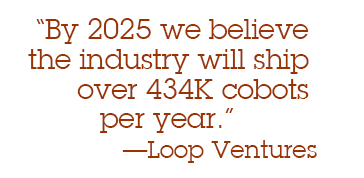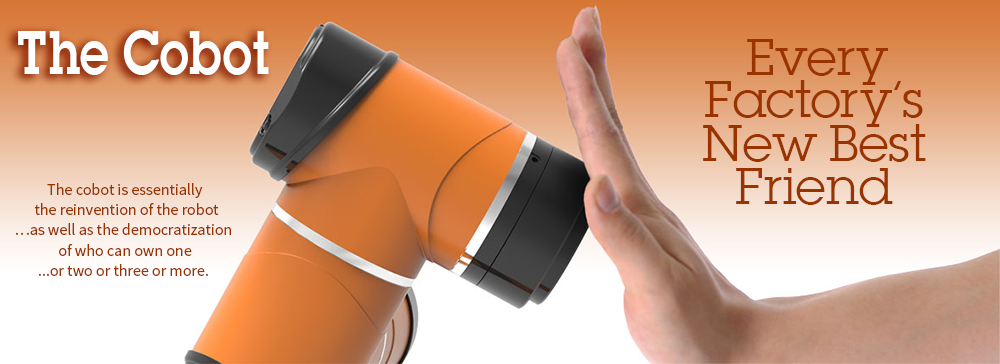
Reinventing Productivity with Cobots
The Promise of Cobots…Delivered!
Initially dismissed as a non-factor, this brilliantly-conceived robot arm has turned the robotics industry on its head. Now, a cobot is a must-have in every robot maker’s product line, or else!
“The global cobot marketplace is projected to grow from $175 million to $3.9 billion by 2024,
at a CAGR of over 55.7 percent over the forecast period.” —Markets and Markets
Barclays Research is calling for nearly TWICE that figure! Loop Ventures tops them all with 434k cobots shipped!
The robot reinvented
The revolution that ushered in the world of cobots is entirely unprecedented in the seventy-year history of robotics. No similar machine has come so far so fast, and has so penetrated the marketplace like this lightweight, highly maneuverable robot arm that has so quickly become the everyman tool on a global scale for any size manufacturer…and lately, for most any warehouse as well.
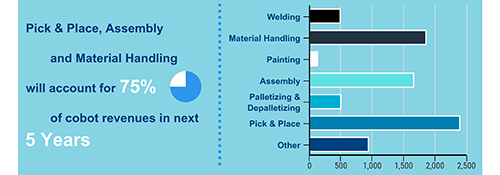 In fact, in the hands of innovative end users, the applications for which cobots have been utilized borders on the mind-boggling—everything from kitchen chef to surgical helpmate to welder to machine tender to tireless pick ‘n pack specialist. You name it, some enterprising someone somewhere has already or is now adapting his or her cobot to take on some new job function.
In fact, in the hands of innovative end users, the applications for which cobots have been utilized borders on the mind-boggling—everything from kitchen chef to surgical helpmate to welder to machine tender to tireless pick ‘n pack specialist. You name it, some enterprising someone somewhere has already or is now adapting his or her cobot to take on some new job function.
Such versatility is always a good sign that a new tool might be very special.
Baked-in limitations
The cobot also exposed the limitations in the traditional industrial robot: For simple, labor-intensive manufacturing operations of under 20 lbs.—which account for over 80 percent of all manufacturing worldwide—the caged industrial robot was either ill-suited to the task or found it impossible to perform at all…and, safety aside, was way too expensive to buy, install and program for that 80 percent.
Strong and fast, but dangerous, and yoked most times to a single task, caged industrial robots are the darlings of automation, mostly to those with specific physical jobs to be done and the cash to afford them. To most everyone else, the cobot looks mighty appealing.
In short, the elegantly engineered, simple, user-friendly and cheap cobot has changed everything. It has turned the robotics industry on its head and sent every industrial robot manufacturer scrambling to get a cobot into its product line, or else!
With a cobot there’s basically a low to zero high-tech intimidation factor and no sticker shock for manufacturers, especially SMEs, wary of wildly expensive robots needing cages, pricey expertise for installation and programming, and a scary timeline for return on investment.
SMEs, even with no current robots on their production floors or knowledge of how to use a robot, “get it” on how to integrate this new-age machine into their work flows. A cobot’s unassuming look, more like a juice squeezer from Ikea than an industrial robot, makes an instant connection with potential end users.
A recent paper, Revisiting the End User’s Perspective in Collaborative Human-Robot Interaction, points out that this first-look, instant connection helps to facilitate both cognitive and emotional understanding of the cobot’s role in the manufacturing process. It’s a machine helper, not a hulking intimidator. With that comfort zone quickly established, end users more easily see the “cobot fit” into their production lines. It’s a vital first-look connection that has been key to the cobot revolution.
Reinventing productivity
The cobot is essentially the reinvention of the robot…as well as the democratization of who can own one…or two or three or more. Relatively inexpensive, easy to set up, and a breeze to operate, these nimble, steel-collar factory workers have gained rapid acceptance with end users and chalked up impressive gains in productivity.
MIT scientists testing cobots on BMW production lines have shown that cobot-human teams working together “were about 85 percent more productive than either alone.”
A bump in global productivity would be a most welcome event.
The Economist reported the “global level, [of] total factor productivity fell last year, was flat the two years before, and has barely budged since 2007.” With the world wallowing in tepid productivity numbers, cobots offer more than just a tireless substitute for human labor.
William Xie, chief engineer at China’s Xiamen Runner’s bathroom fixture plant is a good example. Xie was surprised by the flexibility, compact size and efficiency of that cobots offered. He even has two different cobots occupying the same space doing two different operations and others working upside down. Redeployments of the cobots on his production line take less than one hour to set up.
So, what do true believers like Xie do with a winning machine? They buy more. Xie now has sixty cobots in his work force.
 Let the buying begin
Let the buying begin
In 2016, IDC Research went so far as to predict that by 2018: “30 percent of All New Robotic Deployments Will Be Smart Collaborative Robots That Operate Three Times Faster Than Today’s Robots and Are Safe for Work Around Humans.” It didn’t happen.
2027 is the new update for 30 percent (see chart above).
Even if IDC was off is in its estimated numbers, it’s right on the money with its portrayal of the cobot zeal that is ramping up worldwide.
The take up of cobots in the marketplace has also demonstrated historic speed and growth; forecasts for future sales border on the spectacular: Markets and Markets is but one of many research organizations foretelling very similar sales pictures well into the year 2020. The global cobot marketplace, reports Markets and Markets, is projected to grow from $175 million to $3.8 billion by 2024, at a high CAGR of over 55.7 percent over the forecast period. Again, spectacular growth over the coming years.
Initially dismissed as a non-factor, this brilliantly-conceived robot arm has turned the robotics industry on its head. Now, a cobot is a must-have in every robot maker’s product line, or else!
The chart below from Barclays Research is particularly bullish on the coming cobot future. Note the takeoff in sales beginning 2017, and the quick ascent into 2025. Astounding!
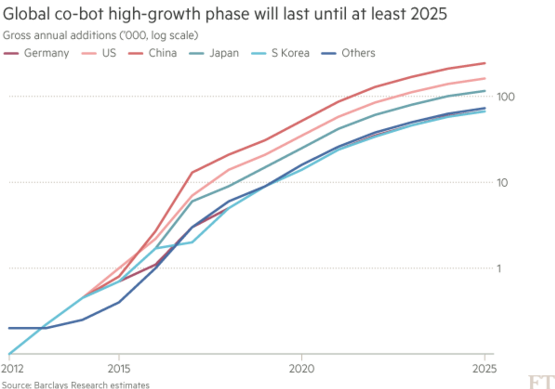
Barclays’ picks for its “cobot high-growth phase”: China, followed closely by the U.S., will experience enormous take up in cobot sales and deployments. The good news for cobot providers is that in both China and the U.S. cobot penetration has been minimal to date. The market is gapingly wide open!
Japan, along with the Germany and Korea trendings, are displaying more massive potential that looks almost too good to be true.
In fact, Barclays Research reckons that the global cobot marketplace will be $11.5 billion by 2025 (some $7 billion over the Markets and Markets forecast). Such a projection, notes Reuters, “would be roughly equal to the size of the entire industrial robotics market today.”
To get an idea of the numbers of cobots that can be sold into this market, a quick look at market leader Universal Robots’ 10K says volumes (acquired by Teredyne in 2015): As December 31, 2018, Universal Robots’ installed base was 30,000! That’s all! After a decade of making and selling cobots. All of which are produced in a single factory in its home country Denmark, thousands of miles distant from the massively massive cobot marketplaces, especially Asia.
Loop Ventures’ co-founder Andy Murphy took an analytical look at this cobot future and concluded:
“Although the market looks small today, we believe we have approached an inflection point and anticipate…By 2025 [the] industry will ship over 434K cobots per year and equate to a ~$9.2B market. This growth implies a 56.5 percent CAGR.”
Regarding that ~$9.2 billion, here’s an interesting aside from Loop Ventures: “when we consider the number of applications outside of manufacturing, we believe our $9.2B market opportunity in 2025 is likely underestimating the true potential of this market.” With manufacturing’s potential market for cobots astounding in magnitude, how big could this “outside of manufacturing” market become?
Noteworthy stat: “over 434K cobots per year”. If only half that number, we’re still looking at a market potential that is beyond extraordinary. The real question TBD going forward is whose logo will be on most of those cobots?
Will a Toyota suddenly swoop in and start banging out cobot Corollas by the millions?
See also: What if Toyota Made Cobots…by the Millions?
Regardless of the numbers bandied about in the projections, all present a rollicking outlook ahead in sales and deployments for cobots.
The cobot revolution is made even more amazing in view of the fact that the first marketable cobot in quantity, Rethink’s Baxter (ceased operations in October of 2018), got its first public showing in Pittsburgh in 2012. It’s been a mighty brief eight years since Pittsburgh, during which no fewer than forty manufacturers sporting 150 different cobot models have appeared on the scene with a cobot.
That’s got to be a Guinness World Record, if Guinness is watching cobots, which it isn’t. Fortunately, Cobotics World keeps a close eye on the cobot sweepstakes of manufacturers and their machines (grippers are also closely watched).
Each of these forty-plus cobot builders is betting on a global cobot boom—which is now well underway—hopefully to catapult each into respectability, maybe even to glory. All, of course, realize how unlikely it is that forty different cobot makers will survive the gauntlet of the marketplace.
The computer hardware industry couldn’t pull it off; the list of companies that ceased to be is epic. Cobots are undoubtedly facing the same fate. Some with good product will get scooped up early by the big players, as Gomtec’s Roberta cobot arm was when acquired by ABB in 2015; others will need some sort of deep-pocketed, big daddy to attain unassailable market leadership, as has happened with Universal Robots acquisition by Teradyne in 2015.
By any measure, the cobot has delivered, and magnificently so.
Brent Gillespie’s $50 word-prize
The origin of the word “cobot” goes to Brent Gillespie, a postdoc at Northwestern University, who in 1969 coined the word as part of a lab competition to come up with a simpler, kinder term than “programmable constraint machine”, which was the machine’s early moniker. Gillespie got $50 for the naming. The Wall Street Journal selected cobot as one of its Words of Tomorrow in 2000.
Although Northwestern University also claims to be the originator of the cobot itself, as well as a spinoff company called Cobotics LLC in 1996, its devices were more like movers, called Intelligent Assist Devices, used in the material handling industry rather than a robot arm. However, the same lab’s Carl Moore concepted and engineered, albeit in a very rudimentary form, the armed robot that today we know as a cobot.
For years thereafter, the cobot existed mainly as a sideshow at IEEE conferences. Even as late as 2009, Xiaobo Li’s Modeling and Control of a Powered Cobot was much closer to current cobots, but still off the mark.
It took MIT’s Rod Brooks, his company Rethink Robotics (2008), and $5 million from Jeff Bezos (Bezos Expeditions) in 2009, to build a true line of succession that led to cobot Baxter’s first public appearance in Pittsburgh in 2012. Baxter drew lots of excitement, media attention, and considerable head scratching. Was this ungainly looking red machine with two arms and a square monitor for a face actually the industrial robot that would capture the world’s attention as a serious production worker? Initial sales were as lethargic as Baxter’s production speed.
However, Brooks had planted the seed of what a cobot could be, grew that seed at Rethink, and then brought it to market. Baxter was the first-ever cobot that anyone could actually buy ($25,000) and put immediately to work. Rod Brooks made the cobot a reality.
Is a cobot shakeout ahead?
It took three Danes as co-creators, led by Esben Østergaard, to conjure up and build what we know today as the robot arm that has ignited the cobot revolution.
Far and away, Østergaard’s Universal Robots is leading in the cobot marketplace, but things might be about to change.
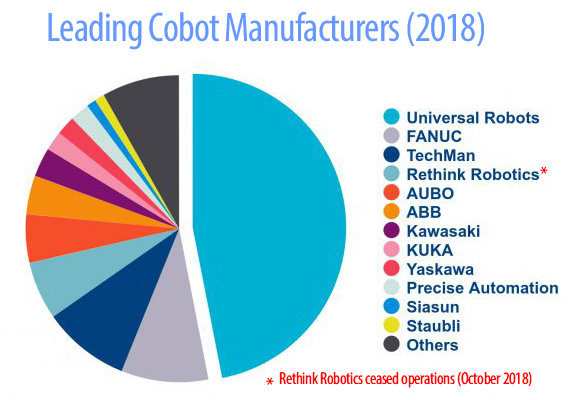
2020 is an opportune time for a few newbie disruptors to pull off the cobot version of Clayton Christensen’s The Innovator’s Dilemma. In that book, Christensen “demonstrates how successful, outstanding companies can do everything “right” and yet still lose their market leadership – or even fail – as new, unexpected competitors rise and take over the market.”
And as high-tech innovation would have it, “new, unexpected competitors” are indeed on the rise. Forty-plus by last count.
Look out world, especially Asia, and especially China, for the beginnings of a wild and wholly cobot ride for 2020.
See related:
Cobots as Force Multipliers
Is Disruption Ahead for the Cobot Revolution?
Does the cobot revolution need the revolution of e-commerce to drive wide-scale adoption?


